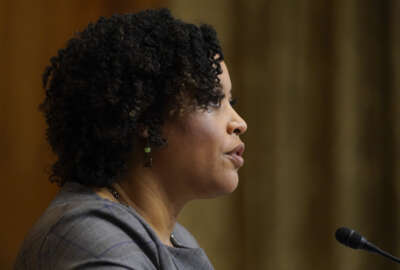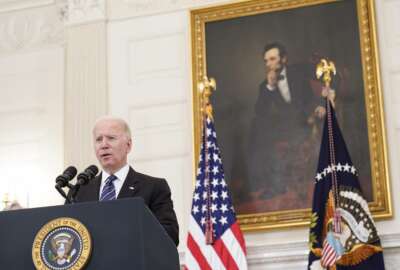Why Biden’s internal federal workforce and external equity initiatives go hand in hand
Federal agencies are simultaneously assessing the state of diversity, equity, inclusion and accessibility inside their own workforces and in the external services...
For the Biden administration, the drive to improve diversity and inclusion inside the federal workforce and simultaneously embed principles of equity in the external government services agencies provide to the public are one in the same.
One initiative can’t succeed without the other, and agencies won’t improve customer service without focusing on both, administration officials said.
“Focusing on the workforce — making sure that we are recruiting people from across the country, from all different walks of life — is an actual, critical step in designing good customer experience,” Clare Martorana, the federal chief information officer, said Wednesday at a virtual CX summit produced by ACT-IAC.
It’s why the Biden administration sees an executive order on advancing racial equity in underserved communities through government, which the president signed on his first day in office, and a separate EO on improving diversity, equity, inclusion and accessibility inside the federal workforce as policies that go hand-in-hand.
“Having multiple executive orders is extremely helpful,” Kimberlyn Leary, an OMB senior equity fellow and senior vice president of the Urban Institute, said Tuesday at ACT-IAC’s CX summit. “It reminds us that when we’re talking about diversity, equity and inclusion, it’s not just one category. It really involves multiple dimensions of government service.”
Both Leary and Dalal are serving on a detail with OMB through the Intergovernmental Personnel Act, where they’re helping agencies implement the equity executive order.
The EO charged agencies with assessing the state of equity within their organizations, operations and external-facing public services.
Agencies have until January 2022 to details their plans for improving the equity of the services they provide to the public, particularly those with a high impact.
Leary said those activities will help agencies develop the tools to tackle the second executive order, which the president signed in June. That EO, similarly, calls on agencies to assess the state of diversity, equity, inclusion and accessibility within their own workforces.
“If you start thinking about equity in a service delivery context, and then another EO comes along and asks you to think about hiring and retention, you already have some skills, framework and language that will augment this other work stream, now on workforce, that you’ve been asked to take up,” Leary said. “Likewise the work that’s been done on the workforce and reshaping hiring and retention and other kinds of internal processes can only help augment how we think about service, who counts as a stakeholder and whose voice gets included in the conversation.”
So far, several lessons have become abundantly clear as agencies assess and plan for the equity EO. Dalal said many agencies need to consider new ways to engage externally with the public — and better reach stakeholders whose voices are often overlooked.
OMB issued a request for information earlier this year, which asked the public for recommendations on how agencies could advance equity in procurement and contracting, grant making and their interactions with communities and other stakeholders.
The RFI generated more than 500 responses, Dalal said.
“We saw a big focus on conducting meaningful and long-term community engagement, which means actions like making sure community members — especially those who have lived experiences — are brought into the process from the very early stages of program discussion and design and have a seat and a voice at every decision making process,” she said. “Agencies should also be thinking about establishing advisory boards, commissions and task forces that are inclusive of those community members with lived experience and also compensate them for their time and their expertise.”
Agencies also need better ways to collect data about those using their services, as well as additional channels for the public to submit their feedback, challenges that OMB detailed last month in a report describing methods for assessing equity.
It’s a big job for many agencies, one that will take willing leaders to prioritize and apply an equity lens on every decision they make, Dalal said.
“This is a long and iterative journey. Failures will happen. Snapbacks will happen, and it’s important not to be discouraged by that and just know that this will not change overnight,” she said. “Equity is also everyone’s job. Every single person in this room, I can guarantee you, has something that they can do in their roles to advance equity. It’s not just on HR, and it’s not just on the chief diversity officer, which is a very common misconception when it comes to advancing equity and inclusion.”
The administration is embedding these equity principles into its customer experience work, and CX metrics are part of agency executives and leadership performance standards, priorities OMB has detailed in last month’s A-11 update.
The administration also selected eight new high-impact service providers, which include the Census Bureau and the Agriculture Department’s Food and Nutrition Service and Rural Development, as well as several other Treasury Department subcomponents.
A total of 33 agencies and subcomponents are now considered “high-impact service providers.”
“We’re excited to work with each HISP as they designate and work to define priority services, a unit of delivery, unlike an organizational unit, program funding line or budget account, that actually means something to a customer as they meet a need,” said Amira Boland, OMB’s customer experience lead. “These services should have defined measures of performance, equity and burden, and feedback should be collected in the context of that service so as to find the most meaningful opportunities for improvement.”
While the administration is working with individual organizations to improve their own programs, OMB is also partnering with the President’s Management Council to select additional cross-agency government services that are ripe for improvement, Boland said.
Copyright © 2025 Federal News Network. All rights reserved. This website is not intended for users located within the European Economic Area.
Nicole Ogrysko is a reporter for Federal News Network focusing on the federal workforce and federal pay and benefits.
Follow @nogryskoWFED






